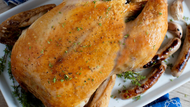The Festive Cockerel
Posted by Copas Farm Shop on 15th Sep 2025
As you may know, I love Christmas. I love the buzz of a kitchen full of roast meats, the smells drifting through the house, and that moment when everyone gathers round the table. And if you’re looking for something a little different — or perhaps you’ve got family over and want something special for Christmas Eve or Boxing Day, a free-range cockerel is a wonderful choice. It’s hearty, full of flavour, and makes a striking centrepiece for the table. So, I’m going to walk you through how I like to prepare and cook it.
Why choose a cockerel?
Before we dive into the cooking, here’s why a good-quality free-range cockerel is such a treat:
- Slow rearing gives the meat a richer, deeper flavour.
- A bird that’s been raised well has better texture and succulence.
- It generally serves 6–8 people, making it perfect for smaller gatherings where a whole turkey might be too much.
- It offers something just a little bit different while still being familiar and comforting.
What you’ll need
Here’s a list so you’re organised well ahead:
- A high- quality and free-range cockerel (around 3 kg)
- Salt and pepper
- Butter or oil (butter gives richness; oil helps crisping)
- Aromatics: e.g. onion, garlic, herbs (thyme, rosemary, sage)
- A roasting tray with rack if possible
- Meat thermometer (helpful, though you can use visual / juice-test too)
- Carving knife and board
Step-by-step: How to cook it perfectly
Here’s my method. It works. I’ve tested it, and people keep asking for seconds.
- Take the bird out of the fridge at least 30 minutes before you roast it. Letting it come towards room temperature helps it cook more evenly.
- Preheat the oven to 200°C (180°C fan).
- Season and sear
- Rub the bird inside and out with salt, pepper, and, if you like, butter under the skin (especially on the breast). Some softened herb butter works wonders.
- Pop it in the oven at the higher temperature for about 20 minutes to get the skin going and give it a head start.
- Reduce temperature
- After those first 20 minutes, reduce the oven to about 180°C (160°C fan).
- Then roast at this temperature for about 30 minutes per kilogram. For a 3 kg bird, that’s about 1½ hours(roughly) once the temp is lowered.
- Check doneness
- Use a skewer or small sharp knife to pierce the thickest part of the thigh. The juices should run clear, not pink. If they’re still a little rosy, give it another 10 minutes or so.
- If you have a meat thermometer, you’re aiming for about 75–80°C internal temperature in the thigh. (If you go higher, make sure breast doesn’t overcook resting is key.)
- Rest the bird
- Once cooked, remove from the oven and let it rest for at least 15 minutes (longer is fine if you cover it loosely with foil). This allows juices to redistribute, meaning your slices will be moist and succulent.
Tips & tweaks for extra flavour or showing off
- Stuff the cavity with aromatics: halved onions, crushed garlic, lemon quarters, fresh herbs. They’ll flavour the meat from the inside.
- Butter under the skin (especially over the breast) gives richness and helps crisping, but if you prefer oil for a lighter skin, that works too.
- Basting is optional. A light baste (with melted butter or the bird’s own juices) every 30 minutes can help, but too much lifting of the tray or opening the oven weakens the heat and slows crisping.
- For crispy skin, finish with a blast of higher heat (if your oven allows) or switch to grill for the final few minutes—just be vigilant so it doesn’t burn.
- Don’t waste the giblets: simmer them with some herbs and onion to make a rich gravy or stock.
Planning timing (so Christmas runs smoothly)
- Make sure you give the bird plenty of time to rest before carving — it really does make all the difference.
- If it’s ready before the sides, loosely cover with foil and keep warm.
- Side dishes can often be prepped in advance (veg peeled, potatoes par-boiled, etc.), which eases the pressure on the day.
Why it’s worth doing well
When cooked with care, a cockerel gives you something just a little different from turkey: a deeper, richer flavour that still feels festive, with moist, tender meat that pairs beautifully with all the trimmings. It’s a lovely way to make Christmas Eve or Boxing Day feel just as special as the big day itself.

